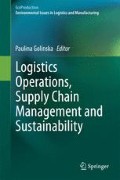Abstract
This chapter presents the concept behind a simulation model reflecting the functioning of a supply chain in the context Sales and Operations Planning (SOP) working in business in practice. The methodology assumed by the authors was based on: the analysis of integration models of planning processes, with a particular focus on the concept of Sales and Operations Planning, accompanied by the analysis of the surveys findings. Literature on the subject features SOP mainly as a business tool based on a collective decision making on the tactical level. The solution put forward in this article represents a systemic approach to the planning process integration. It includes the mechanisms of coordination put in place in a wide process planning structure, applied both in companies and within the supply chain. The model serves as a point of departure for further works related to the simulation of the material flow within a supply chain in the context of integrated planning. The final results of whole research will be employed in defining the impact of integrated process planning on the functioning of the supply chain, in particular on the coordination of the material flow and achieved results, as measured by economic and logistics metrics.
Access this chapter
Tax calculation will be finalised at checkout
Purchases are for personal use only
References
Aberdeen Group (2008) Sales and operations planning: aligning business goals with supply chain tactics. Aberdeen Group, Inc., a Harte-Hanks Compan, Boston
Adamczak M, Domański R, Cyplik P, Pruska Ż (2013) The tools for evaluating logistics processes. Logforum 9(4):255–263
Affonso R, Marcotte F, Grabot B (2008) Sales and operations planning: the supply chain pillar. Prod Plann Control 19(2):132–141
Blackstone JH, Jonah J (2008) APICS dictionary, 12th edn. University of Georgia, Georgia
Chaberek M (ed) (2001) Modelowanie procesów i systemów logistycznych. Wydawnictwo Uniwersytetu Gdańskiego, Gdańsk
Chung WWC, Leung SWF (2005) Collaborative planning, forecasting and replenishment: a case study in copper laminate industry. Prod Plann Control 16(6):563–574
Eng TY (2005) Mobile supply chain management: challenges for implementation. Technovation 26:682–686
Fertsch M (2006) Podstawy logistyki. Instytut Logistyki i Magazynowania, Poznań
Głowacka-Fertsch D, Fertsch M (2004) Zarządzanie produkcją. Wyższa Szkoła Logistyki, Poznań
Gray CD (2007) Sales and operations planning standard system: with reference software. Trafford Publishing, Bloomington, USA
Hitachi Consulting’s (2011) Chemicals Practice, Sales & Operations Planning (S&OP) Survey Review. Hitachi Consulting, Dallas
Kelle P, Akbulut A (2005) The role of ERP tools in the supply chain information sharing, cooperation, and cost optimisation. Int J Prod Econ 93(94):41–52
Klimek A (2005) Miejsce i znaczenie głównego harmonogramu produkcji w zintegrowanych systemach informatycznych opartych na standardzie MRP II/ERP. In: Fertsch M (ed) “Logistyka produkcji”, pp 110–122, Biblioteka Logistyka, Poznań
Lapide L (2007) Sales and Operations Planning (S&OP) Mindsets. J Bus Forecast Spring 26(1):18–27
Łopatowska J (2007) Wykorzystanie wnioskowania logicznego w planowaniu i sterowaniu produkcją. In: Fertsch M, Grzybowska K, Stachowiak A (eds), Logistyka i zarządzanie produkcją – nowe wyzwania, odległe granice, pp 252–264, Instytut Inżynierii Zarządzania, Poznań
Malone TW (1987) Modeling co-ordination in organisations and markets. Manag Sci 33(10):1317–1332
Mellon C, Allen B, Prokopets L (2010) Putting S&OP on the fast track. Supply Chain Manag Rev 14(1):41–50
Muzumdar M, Fontanella J (2007) The secrets to S&OP success. Supply Chain Manag Rev 4(1):33–41
Nakanoa M, Akikawab T, Shimazuc M (2013) Process integration mechanisms in internal supply chains: case studies from a dynamic resource-based view. Int J Logistics Res Appl 16(4):328–347
Parker K (2008) S&OP encompassing broader financial and performance parameters. Manufact Bus Technol 26(1):28–39
Romano P (2003) Co-ordination and integration mechanisms to manage logistics processes across supply networks. J Purchasing Supply Manag 9(3):119–134
Stahl RA (2008) Executive S&OP: managing to achieve consensus. Foresight Fall (19):33–41
Ventana Research (2007) Sales and operations planning research study results. Ventana Research, San Francisco
Ventana Research (2012) Optimizing business performance with sales and operations planning the role and importance of demand planning in S&OP. Ventana Research, San Francisco
Acknowledgments
This chapter has been the result of the study conducted within the project entitled “Investigating multi-aspect determinants of integration in backward and forward logistics chains in respect of integrated production planning in the context of using recyclable materials” pursued at the Poznan School of Logistics in Poznan. The project was financed by The National Science Center based on the decision number DEC-2011/03/B/HS4/03419.
Author information
Authors and Affiliations
Corresponding author
Editor information
Editors and Affiliations
Rights and permissions
Copyright information
© 2014 Springer International Publishing Switzerland
About this chapter
Cite this chapter
Adamczak, M., Hadaś, Ł., Domański, R., Cyplik, P. (2014). Modelling Integration Process Planning in the Supply Chain Using SOP Approach. In: Golinska, P. (eds) Logistics Operations, Supply Chain Management and Sustainability. EcoProduction. Springer, Cham. https://doi.org/10.1007/978-3-319-07287-6_11
Download citation
DOI: https://doi.org/10.1007/978-3-319-07287-6_11
Published:
Publisher Name: Springer, Cham
Print ISBN: 978-3-319-07286-9
Online ISBN: 978-3-319-07287-6
eBook Packages: Earth and Environmental ScienceEarth and Environmental Science (R0)

